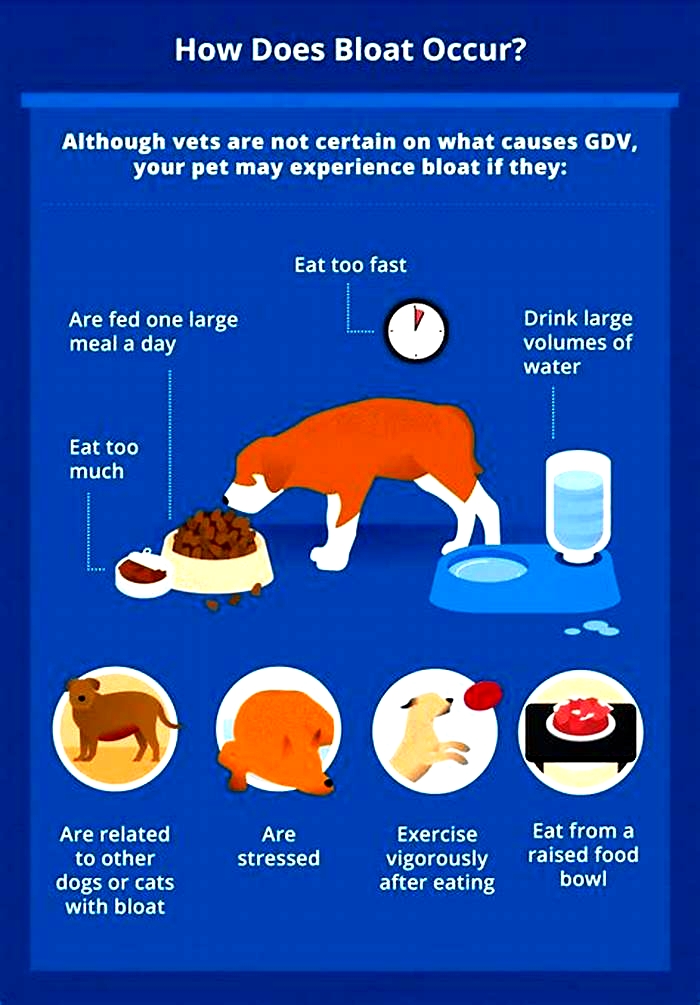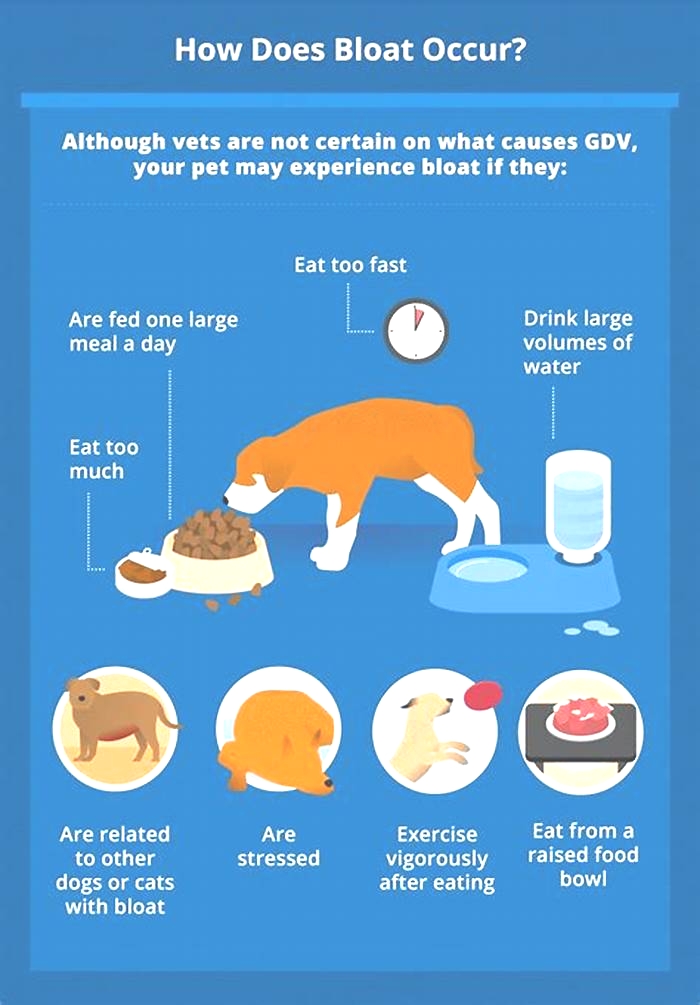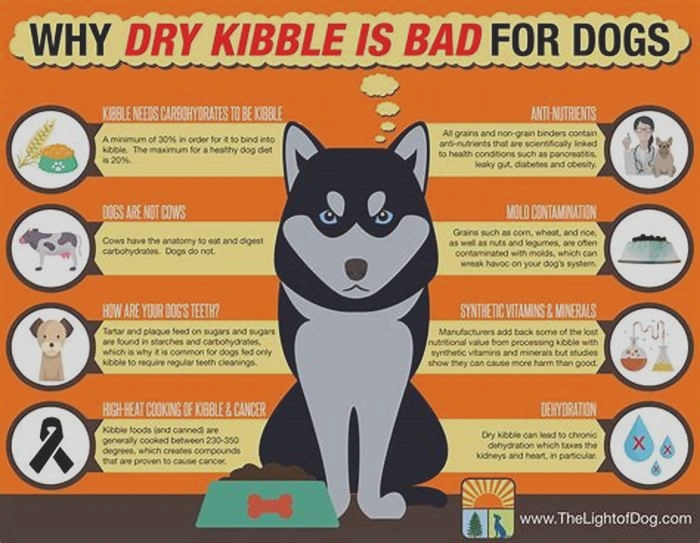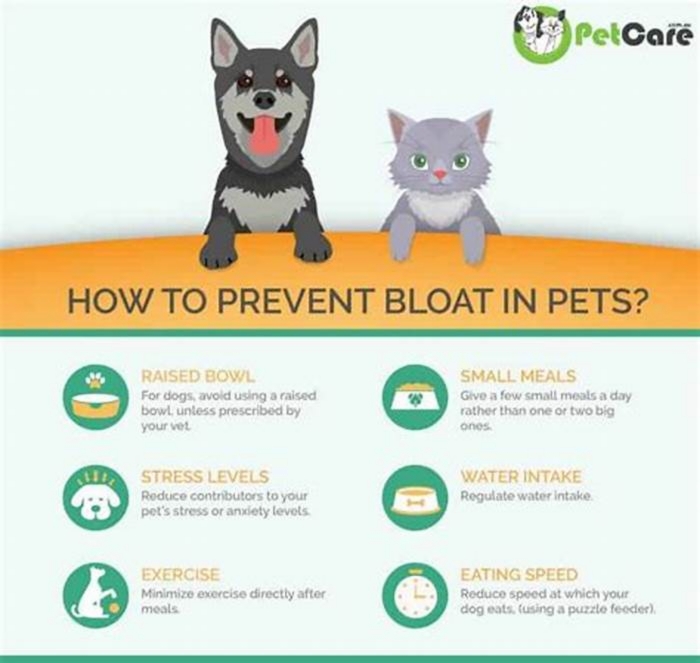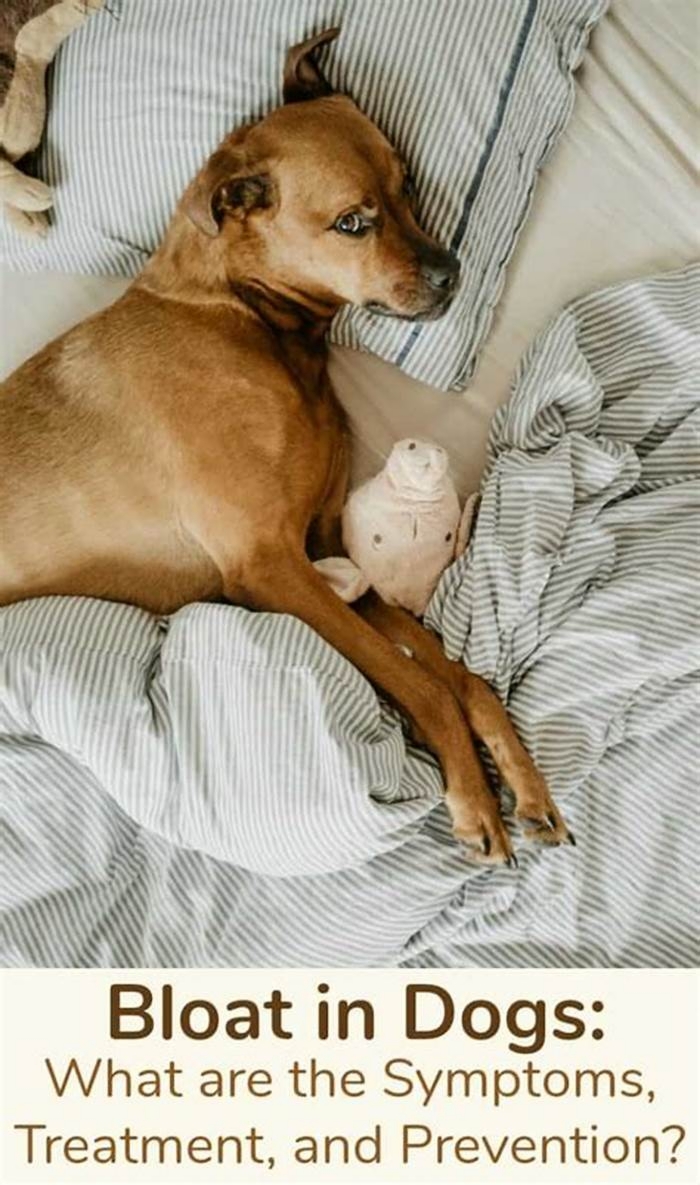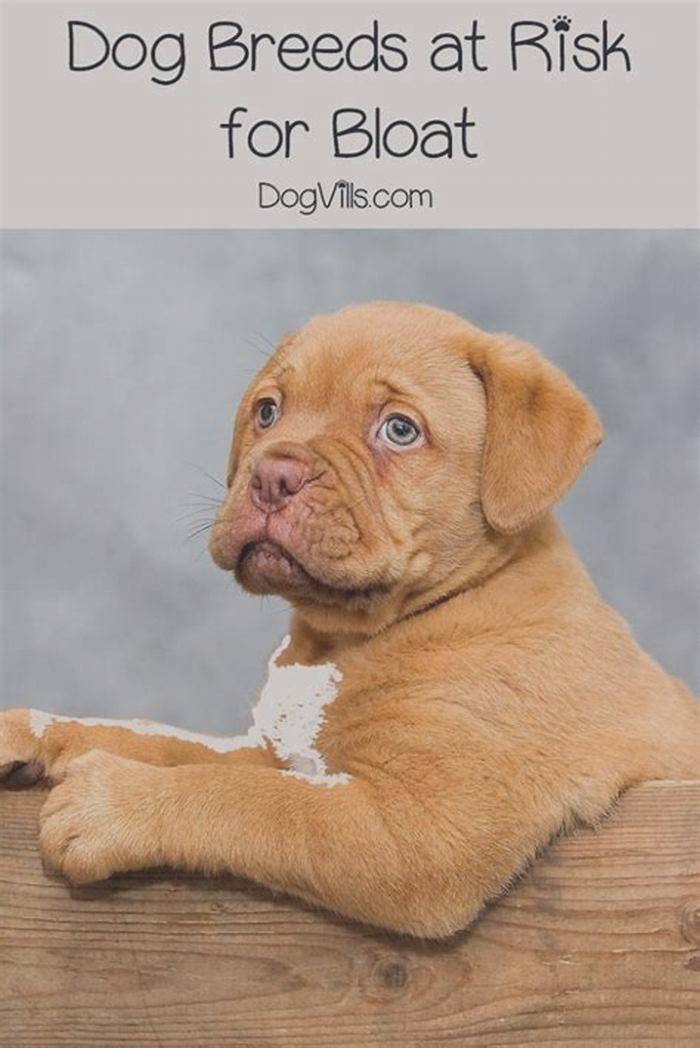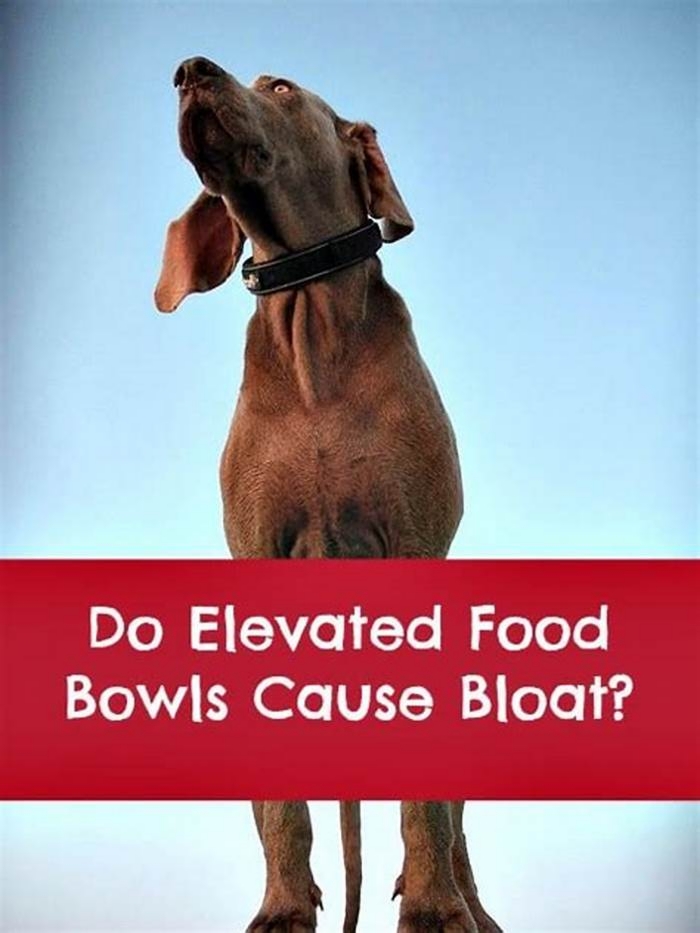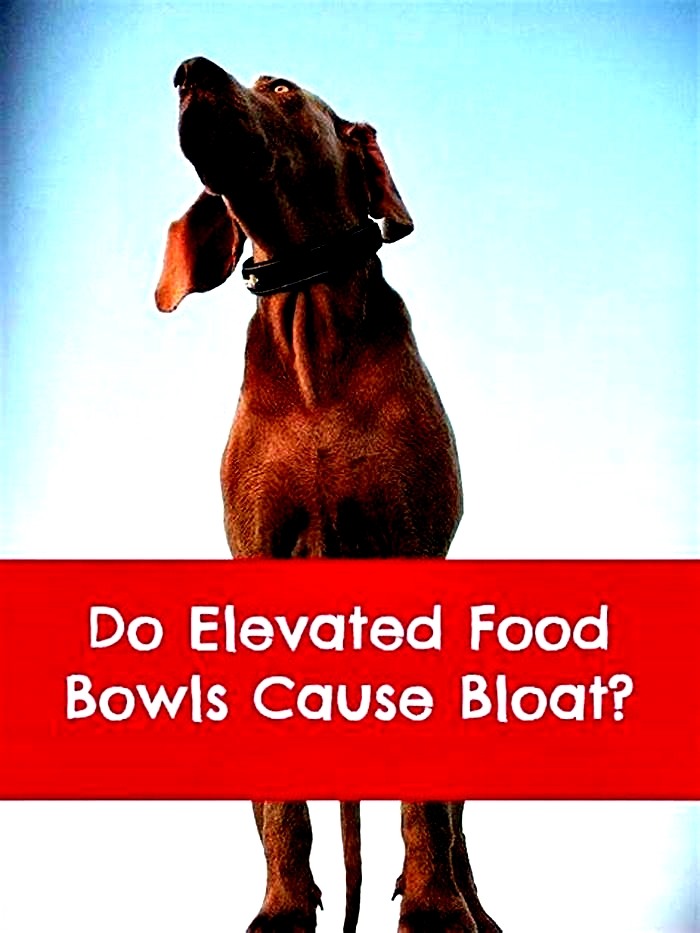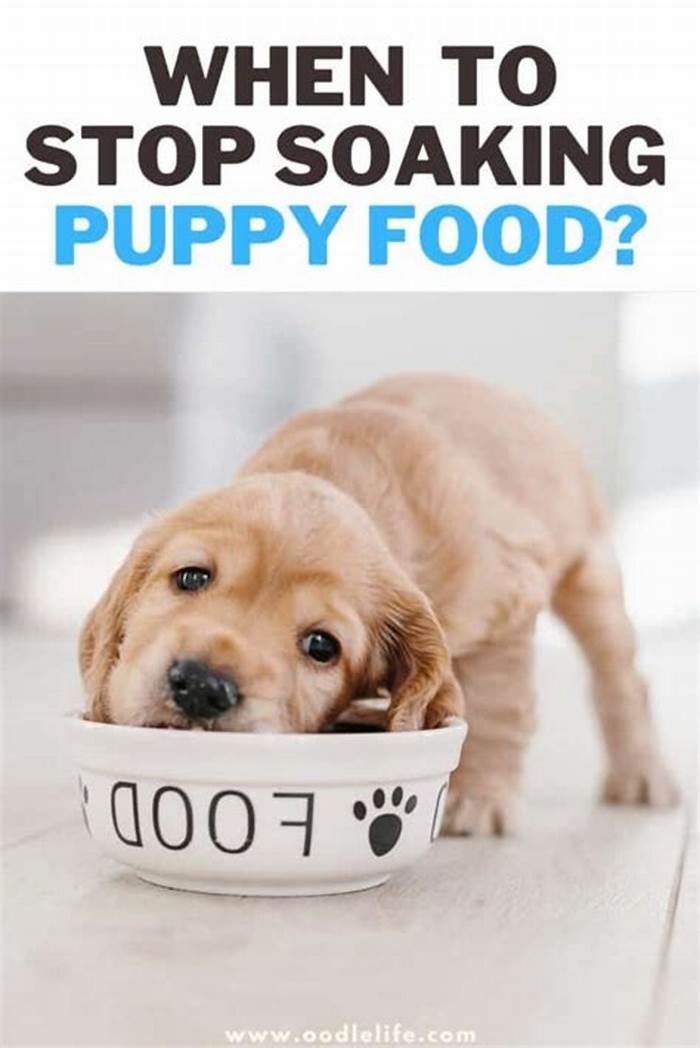What is the main cause of bloat in dogs
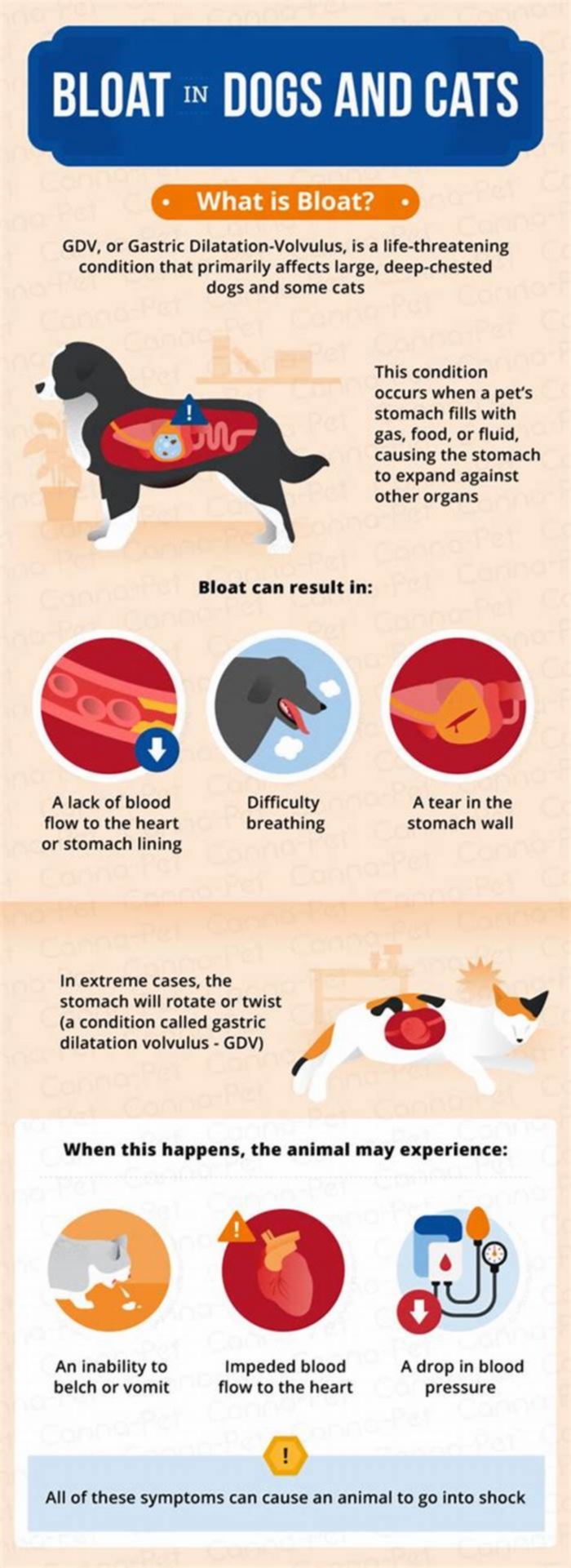
Causes of Bloat (GDV) in Dogs
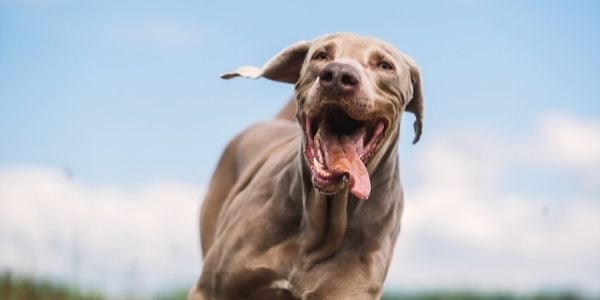
Bloat, also known as GDV or Gastric Dilatation Volvulus, is a serious condition primarily seen in large, deep-chested dogs and is considered a serious emergency in veterinary medicine.
Therefore, if you believe your dog is suffering from bloat, please take your dog immediately to a veterinarian for assessment.
What Can Cause GDV?
Research is ongoing; therefore, all of the possible causes or contributing factors are unfortunately still unknown or under investigation. However, although there is still much to learn, we do know that several factors may contribute to one dog developing GDV over another, including the causes listed below.
- Breed: Breed plays a large role in the development of GDV. GDV typically affects (large size, deep-chested dogs). However, some breeds are more predisposed than others to the condition. See the section on breed predisposition and the list of common breeds that suffer from GDV further on in this article.
- Family history of GDV: Especially if there is or was a first-degree relative that suffered from an episode of GDV, such as a littermate or parent. If you know your dog's breeder, asking them if this has ever been an issue for their breeding dogs and/or offspring is a good way to know if your dog could potentially be at risk in the future.
- Stress, anxiousness, or nervousness: (particularly when eating) may predispose a dog to an episode of GDV. Breeds that are more anxious or have a more highly strung personality may be more likely to experience a GDV event.
- Frequency and amount of food fed: Feeding one large meal per day may result in an exaggerated weighing down of the stomach resulting in excessive stretch being placed on the hepatogastric ligament, which is the ligament responsible for maintaining the stomach's normal position within the abdomen. Once this ligament has been stretched excessively, this allows the stomach to move more freely within the abdomen, including the freedom to rotate on itself, which it ordinarily would be incapable of doing if the hepatogastric ligament was taut.
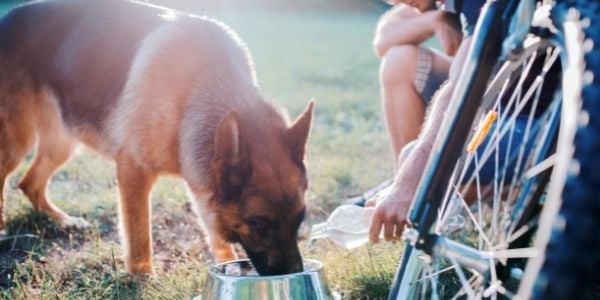
- Exercise and timing of food: Exercise, especially excessive, and then immediately feeding a dog may result in the dog swallowing large amounts of air while eating (as they are likely panting). This air fills up in the stomach, resulting in bloat and possibly GDV.
- Ingestion of large volumes of water: Drinking a lot at one time (particularly during, before, or after exercise) may increase the amount of air swallowed (similar to feeding after exercise).
- Comorbidities: Conditions that decrease intestinal motility, such as inflammatory bowel disease, food allergies, previous gastrointestinal surgery, and others, may result in the dysregulation of a dogs gastric motility (i.e., movement of food through the intestines) and consequently may cause an episode of GDV.
- Being underweight or thin: GDV is said to occur more commonly in underweight and/or thin/lean dogs than in overweight ones. The reason for this is still being investigated. However, it has been hypothesized that this is because overweight or fat dogs have less space in their abdomen for their stomach to fill with gas and ultimately rotate. Whereas a thin, lean or underweight dog has a decreased amount of fat within their abdomen, increasing the amount of room their stomach has to move around and fill with gas. This does not, however, mean, under any circumstances, that you should overfeed your dog in an attempt to make them overweight so that this *may* decrease their chance of developing GDV. Overweight dogs face a multitude of other health problems that lean or ideal weighing dogs are less likely to suffer from, such as diabetes, arthritis, and other joint diseases, ligament ruptures or tears, as well as many others.
- Age: See the section below for what aged dogs are more susceptible to this condition.
- Gender: Males are more at risk than females; as to why this is, this hasnt been determined as of yet. However, it has been suggested it is due to their larger size and deeper chests. Studies are ongoing.
Diet: Although research into the causation and link between specific dietary factors and the development of GDV continues, there have been some commonly identified factors when it comes to what a dog is fed and the development of GDV.Feeding dry food has been continuously linked more and more recently to the development of GDV in dogs. Additionally, if the dry food fed contains citric acid as a preservative, and is slightly moistened before feeding, the risk for developing GDV increases. One study said this caused a 320% increase in risk for developing bloat.Additionally, feeding dry food that contains oil or fat as one of the first 4 ingredients has also been shown to be a common denominator in the development of GDV, increasing the risk by approximately 170%, according to that same study.
However, as of yet, the brand of dog food fed has not been linked to the development of GDV.
Read about preventative measures you can take to help your dog avoid these issues and an incident of GDV.
Age of Dog
As with most animals, with age comes an increase in the development of various diseases. And this is no different when it comes to GDV/bloat.
Bloat/GDV in older, larger breed dogs
For large breeds, after they reach 5 years of age, the risk of developing GDV/bloat has been said to increase by approximately 20% each year older they get. Whereas with giant breeds, after they reach only 3 years of age, the risk for them developing this condition is said to also increase by approximately 20% each year older they get.
In one recent study, dogs aged above 7 years old were the highest risk group for developing GDV. This study indicated that this was perhaps due to an increase in comorbidities experienced by older dogs, particularly those involving the gastrointestinal system, such as inflammatory bowel disease (IBD)) as well as a slowing down of their gastrointestinal tract (decreased gastric motility) and decreased gastrointestinal tone, resulting in a greater amount of gas build-up, which is a pre-requisite to the development of GDV. Additionally, ligament laxity increases with age. If the hepatogastric ligament that holds the stomach in place becomes laxer as a dog ages, the greater the ability the stomach has to rotate on itself, resulting in torsion and GDV.
"Uncomplicated" bloat or gastric dilatation in older smaller dogs
Uncomplicated bloat is when the stomach fills up with gas but doesn't twist (dilatation without volvulus), and this has been reported to occur more commonly in elderly smaller breed dogs. Again, these facts were extrapolated to be due to the decreased motility and tone of the gastrointestinal system in older dogs resulting in a greater gas build-up, as well as increased comorbidity being suffered by dogs over the age of 7 years.
Bloat/GDV can happen to puppies
Unfortunately, puppies are not completely in the clear when it comes to GDV/bloat. Some puppies inhale their food at a pace equal to that of a land-speed record, resulting in the inhalation of larger amounts of air. And they're notorious for gorging themselves on water (its a game for most puppies!) and then running around at all hours before and after eating despite our best efforts at controlling this. Although puppies, from the age when we first bring them home to around 1 year, are less likely to suffer from GDV than dogs over the age of 1. The reasons are that they are likely to be suffering from less (if any) comorbidities and their superior gastrointestinal motility and tone compared to that of older dogs.
Some Dog Breeds Are at Higher Risk for Developing GDV
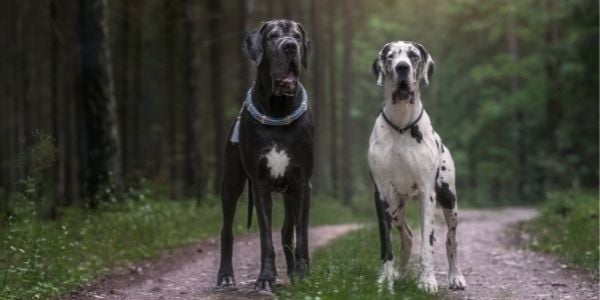 A dog's breed is known as the most significant risk factor when it comes to which dog(s) may suffer from GDV. Theoretically, any dog can suffer from GDV/bloat; however, typically, dogs that are at higher risk for developing GDV are large and giant breed dogs and those with deep or barrel-shaped chests.
A dog's breed is known as the most significant risk factor when it comes to which dog(s) may suffer from GDV. Theoretically, any dog can suffer from GDV/bloat; however, typically, dogs that are at higher risk for developing GDV are large and giant breed dogs and those with deep or barrel-shaped chests.
Although this isn't an exhaustive list of all dog breeds that may suffer from GDV, it is instead a comprehensive list of the most common breeds bloat typically affects:
- Akita
- Basset Hound
- Bernese Mountain Dog
- Borzoi
- Boxer
- Doberman Pinscher
- Dogue De Bordeaux
- German Shepherd
- German Shorthaired Pointer
- Gordon Setter
- Great Dane
- Irish Setter
- Irish Wolfhound
- Labrador Retriever
- Old English Sheepdog
- Saint Bernard
- Standard Poodle
- Weimaraner
In a recent study, the three most likely breeds at risk of bloat were the Great Dane, Saint Bernard, and Weimaraner. However, it must again be noted that ANY dog or dog breed can develop GDV/bloat, including small breed dogs such as Shih Tzus, Pomeranians, and even Chihuahuas.
Mixed Breeds and GDV/Bloat
It must also be mentioned that mixed-breed dogs can and do suffer from GDV/bloat as well; however, their risk of developing GDV is lower than that of pure-bred large breed dogs such as those listed above. This is likely due to their genetic makeup decreasing their predisposition for this condition.
Prevention for dog breeds predisposed to GDV
Many veterinarians will recommend to pre-emptively surgically tack a predisposed dogs stomach to the stomach wall, known as a gastropexy or pexy surgery.
This procedure is the actual emergency surgery performed when a patient suffers from GDV. Often this surgery is recommended before a dog experiences an episode of bloat as a preventive or prophylactic measure and is typically performed when a young dog is being spayed or neutered. Read more about this surgery as an emergency procedure.If you are the owner of a Great Dane, German Shepherd, Weimaraner, or similar breed, this surgery is almost always one I will personally recommend to prevent the possibility of GDV in your dogs future. However, it is not incorrect to discuss this preventative measure with your veterinarian if you own any large breed, deep-chested dog. Prevention, in this case, is far superior to having your dog potentially experience a life-threatening condition.

Ice Water Does Not Cause Bloat
Unfortunately, in one case back in 2007, a patient passed away after what the owner thought was bloat following the consumption of ice water. Surgery confirmed that the patient's stomach was not actually rotated as expected with GDV. However, the dog health rumor mill became very concerned with ice water and its association with bloat or GDV. This has been dispelled as a true cause of GDV, as it has not been able to be reliably repeated in any form of study into the causation of GDV in dogs. As always, it is recommended everything should be given in moderation, just like in people.
Please share your dog's experience with GDV/Bloat.
The survey is anonymous and takes 25 minutes. The information you share will help many more dogs.
Bloat in Dogs
What Is Bloat in Dogs?
Bloat in dogs is a condition in which food or gas stretches a pups stomach, causing abdominal pain. While its more common in large breed or deep-chested dogs, any breed can develop bloat.
When bloat occurs, a dogs stomach begins to expand, or distend, and cuts off blood flow to the abdomen as well as the stomach itself. This may cause injury or death of the stomach wall and without treatment, other organs. Bloat can also put pressure on the diaphragm, a thin muscle that separates the chest from the abdomen. This can cause difficulty breathing in dogs.
In severe cases of bloat, a dogs stomach flips, or twists, and fills with gas. This is called gastric dilatation and volvulus (GDV).
Bloat with GDV cuts off blood flow to a pups stomach and the lower half of their body, making it impossible for food to pass into the intestine. In extreme cases of GDV, a dogs stomach can rupture, and the spleen can also be injured.
All cases of bloat are medical emergencies, and require veterinary intervention to determine the severity. If untreated, a dog with GDV will die within hours. If bloat and GDV are treated immediately, they are often curable.
Symptoms of Bloat in Dogs
Bloat is an uncomfortable and painful condition. Symptoms of bloat in dogs include:
Dry-heaving (also called retching) without vomiting any food. Sometimes a dog might spit out white foam when trying to vomit, which is usually mucus from the esophagus or stomach.
Abdominal swelling (this might not be visible in the early stages of bloat)
Sudden anxiety, pacing, an inability to get comfortable or constantly moving around the room/house.
Positioning the body in a downward-facing pose, where the dogs back half is up, and upper half is down
Panting and drooling
Collapse
Rapid heart rate (tachycardia)
Pale gums
Causes of Bloat in Dogs
Its unknown why bloat and GDV occurs in dogs.
While these conditions can affect in any pup, there are suspected risk factors that can increase the chance of bloat in dogs. These include:
Dogs that ingest large amounts of food or water too quickly
Dogs that weigh more than 99 pounds
Dogs that are male
Dogs that are older
Dogs that are of large breeds and deep-chested
Dogs that exercise immediately after eating
Dogs that eat from an elevated food bowl
Dogs with a family history of bloat
Dogs that eat dry food with fat or oil listed in the first four ingredients
How Veterinarians Diagnose Bloat in Dogs
A veterinarian may suspect bloat and/or GDV by simply seeing a dogs distressed behavior and physical appearance, but they usually perform tests to confirm the diagnosis.
Veterinarians diagnose bloat in dogs with:
Treatment of Bloat in Dogs
If caught in time, bloat is curable. However, treatment of bloat in dogs depends on the severity.
There are no home remedies for bloat in dogs. Dogs with simple bloat are usually hospitalized to receive of intravenous (IV) fluids and medication for pain or nausea as needed. Theyre also walked often to stimulate movement of the gastrointestinal tract to help move the gas and food quickly through the body.
A dog with GDV requires more intense care. This typically includes:
IV fluids with electrolytes to aggressively treat shock and improve circulation to vital organs.
Pain medications andantibiotics to treat discomfort, shock, and any death of tissues from the loss of circulation.
Trocharization, a procedure often used to decompress the air out of the stomach to restore the blood flow.
Electrocardiogram (ECG) to monitor for any heart abnormalities.
Surgery, which is performed as soon as the dog is stable. Depending on the severity of bloat, a vet may have to untwist the dogs stomach and/or spleen. They may alsoremove any part of the stomach wall that has died due to loss of blood flow. The vet will also stitch the stomach to the body wall in a procedure called a gastropexy. This significantly reduces the risk of rotation of the stomach in the future.
Recovery and Management of Bloat in Dogs
After diagnosis, dogs with simple bloat tend to bounce back into their normal lives and routines one to two days after receiving fluids and taking frequent walks.
Following a gastropexy procedure, a dog will remain in the hospital until their pain is controlled and the dog is eating and drinking normally on their own.
The duration of a pups hospital stay depends on their health history and severity of bloat. Their stay may be anywhere from one to two days, to up to seven or more.
Follow your vets discharge instructions regarding surgical aftercare. This includes typically 10 to 14 days of rest, monitoring the incision, and giving oral medications. It may be useful to purchase a cone or recovery suit to help keep your pup from licking/chewing at their surgical incision during recovery.
Prevention of Bloat in Dogs
You can lower the risk of your dog developing bloat by doing the following:
Never leave large bags or bins of food accessible to your dog to avoid overeating.
Do not use raised food bowls unless advised by your veterinarian (some pets require a raised food bowl due to a medical condition).
Have your dog wait at least one hour after a meal or drinking a large amount of water for any exercise or playtime.
Feed your pup small meals a few times throughout the day instead of one or two large meals.
Dont allow your dog to gorge on water when drinking.
Discuss preventative surgery with your veterinarian for breeds at higher risk of bloat. This can often be performed during your pets spay or neuter procedure.
If purchasing a pup from a breeder, be sure to ask if there is any family history of bloat or GDV.
Bloat in Dogs FAQs
What relieves bloating fast in dogs?
If your dog is experiencing bloat, they require immediate medical attention. If the bloat is distension only and the stomach has not twisted (GDV), your vet will treat your pup with fluids, medications, and increased walking. If your dogs stomach has twisted, emergency surgery will likely be required.
Can dogs survive bloat?
Yes. While bloat and GDV are both medical emergencies and potentially life-threatening, with fast medical intervention they can make a complete recovery.
Its important to get your dog emergency veterinary careone to two hours can be the difference between a good and bad prognosis.
What foods cause bloat in dogs?
No specific foods cause bloat in dogs. Large amounts of food and water or exercising after a large meal are more significant concerns.
Research shows that dry dog foods that list oils or fats among the first four labeled ingredients may predispose dogs to GDV.
WRITTEN BY
Katie Grzyb, DVMVeterinarian
Dr. Katie Grzybreceived her Doctorate of Veterinary Medicine from Ross University in 2009. She continued her clinical training at...

